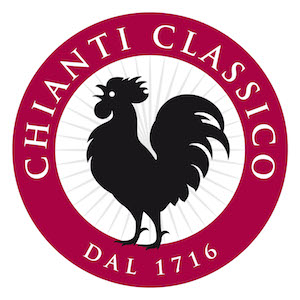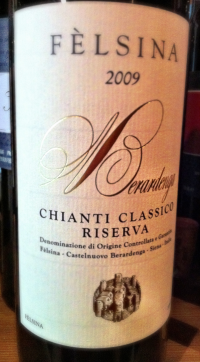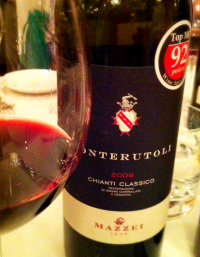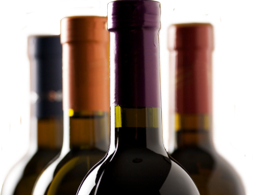May 28, 2013
Getting to Know Chianti Classico
There has been an abundance of Sangiovese washing up on the shores of the west coast recently.
In this case it's the Sangiovese of the historical and venerable Chianti Classico region of Tuscany.
Amid visiting estates, the Consorzio del Vino Chianti Classico led the charge with a tasting and seminar, which attempted to alleviate the confusion over some new regulations, labeling and guidelines (coming shortly into effect) of the denominazione di origine controllata e garantita (DOCG).
What's the deal with Chianti Classico?
"Not all the wine produced in the Chianti zone is Chianti Classico.
To have the right to a denomination is not sufficient. In fact, the provenance refers to a given territory but also all the rules stipulated in the production regulations must be respected. Those rules determine the conditions and the requisites that permit a wine to be decked out with the name Chianti Classico DOCG.
The rules provide for a minimum ratio of 80% for Sangiovese, the typical red variety of the zone. Along with the Sangiovese, other red grapes of the area can be used in a maximum percentage of 20%. These grapes include natives like Canaiolo and Colorino as well as “international” varieties like Cabernet Sauvignon and Merlot, all recommended and/or authorized for the production zone.
Minimum required maturation for the Riserva is 24 months including three months of bottle fining.
Sangiovese, the soul of Chianti Classico
The minimum permitted ratio of Sangiovese grapes used in the production of the wine is 80%, a percentage that can rise to 100%. Sangiovese is the real soul of Chianti Classico.
Production regulations for the “Chianti Classico” controlled and guaranteed denomination of origin (DOCG)
Article 1
The “Chianti Classico” controlled and guaranteed denomination of origin is exclusively for the red wine meeting the requisites established in these production regulations.
Article 2
“Chianti Classico” wine must be made from grapes grown in the production zone delimited by the following article 3 whose vineyards are composed of the following grape varieties:
Sangiovese from 80% to 100%
The wine may also be made from red grapes of varieties suitable for cultivation in the Tuscany Region to a maximum amount of 20% of the varieties listed in the Vineyard Register.
Article 3
The “Chianti Classico” production zone is the one delimited by the Italian Inter-Ministerial decree issued on July 31, 1932, confirmed by article 5 of Presidential Decree 930 issued on July 13, 1963, article 3 of the Presidential Decree issued on August 9, 1967, article 3 of the Presidential Decree issued on July 2, 1984 and article 5 of Law 164 passed on October 2, 1992, autonomously regulated as per the aforesaid article 5 of Law 164/92."
Breaking Down the New Edition, Guidelines and Labels
There is a guarantee that a bottle labeled Chianti Classico (with that recognizable pink DOCG neck tag) contains the wine made from a very specific region of 70,000 hectares between Florence and Siena in Tuscany, Italy.
In the early 1900s this region was made autonomous from the surrounding vineyards of the more far reaching region simply known as, Chianti.
White varieties (traditionally blended into the wines of Chianti) are no longer allowed and the wines of Chianti Classico (as stated above) must be 80-100% of Sangiovese with allowed blenders of: Canaiolo and Colorino as well as some other recognized international varieties such as Cabernet Sauvignon and Merlot.
Narrowed down from hundreds, there have been six clones of Sangiovese recently chosen for their quality by the consorzio (consortium) after a number of years of study and research. These specific clones began to be planted in 2000.
My interpretation of this was that the consorzio has a strong preference for producers to plant these six specific clonal selections in their vineyards. Upon talking to individual producers, it seems more likely they chose the clones of their own liking.
The trademark black rooster is the forefront of Chianti Classico and the consorzio and in addition the region has given birth to updated guidelines of Riserva and the new Gran Selezione.
Chianti Classico Gran Selezione
These wines must be made entirely of estate grapes. There are a host of other rules which must be followed including how many grapes can be grown per hectare, minimum alcohol levels etc. In addition, these wines (which are meant to be the best of the best, the cream of the crop, the pinnacle of a producer's product) must be aged a minimum of 30 months and of those three months must be in bottle. If a producer chooses to age his or her wine longer or crop his vines lower, that's up to them. These are the minimum requirements and you will start to see this level of wine appearing in some of the future 2010 vintage releases.
Chianti Classico Riserva
In addition to general guidelines in production and alcohol levels, these wines must be matured for 24 months (three of those in bottle) - six months less than the Gran Selezione.
Chianti Classico Annata
Also with set guidelines for production and quality, these wines must be aged for a minimum of 12 months.
Got it?
Franco Bernabei
Mr. Sangiovese as he is also known, is perhaps Italy's most respected enologist.
He is a consulting winemaker, chemist and viticulturist who has (and continues to) worked with numerous notable estates across Italy.
He has a specific love of Chianti and therefore the classic Sangiovese grape - the traditional variety of the region.
See his impressive portfolio here
Bernabei prefers organic agriculture and limits the use of sulpher in his wines. His specialty is the study of vineyards and soil types where he is adamant about focusing on micro-zones within each vineyard and treating each as individual rather than as a whole.
Recently, Bernabei was in Vancouver sharing some of the wines he makes. Through a translator he shared his passion for tradition. He feels tradition is the most important thing about Italian wines. Traditional varieties are paramount but he also feels it's important to treat them in a modern way. He believes that you must work in synergy with the current climate changes, rather than fighting them. He also feels is is imperative to take detailed records of each vineyard and vine for future generations and to track how the climate change effects the terroir.
In the recent past, Italy had started to trade fashion for tradition. By planting international varieties such as Merlot, Cabernet and Syrah, they've steered away from their roots, the roots and traditions, which make Italy so unique. Bernabei also feels strongly that the true identity of A region is derived from its inhabitants - the human side of the wine equation.
 Bernabei brought several wines from the Chianti Classico region so share. There was a individuality to each, a reflection of their vineyard, their exposure and their soil. Bernabei brought several wines from the Chianti Classico region so share. There was a individuality to each, a reflection of their vineyard, their exposure and their soil.
Toscolo Chianti Classico DOCG, 2009 - Grown on clay and calcareous soil with a south-southwest exposure, this wine is 95% Sangiovese with 5% Cabernet Sauvignon from 10-20 year old vines. Dark and earthy, sweet with cherries, raspberry, vanilla, licorice and violets with a hint of rose petal. It has a lovely richness in the mouth with sweet fruit, sweet spice, licorice and chocolate.
$22 approx. various locations across Canada
Toscolo Chianti Classico Reserva DOCG, 2009 - For Bernabei, Reserva's can only be made from old vines. The vines are grown on clay and calcareous and it is made from 85% Sangiovese, 10% Cabernet Sauvignon and 5% Merlot. Here, scorched earth, violets and cherry, summer berries, vanilla and cedar appear on the nose. The palate is supple and silky with tobacco, cedar, cocoa and hints of oak. Excellent length and sweet ripe tannins.
$30+ approx. coming soon across Canada.
Felsina Chianti Classico "Berardenga" DOCG, 2009 - A single vineyard wine that has a southwest exposure and is made on soils of mixed quartz, alluvial pebbles and calcareous soils layered with silt and sandstone. Made from 100% Sangiovese is offers spicy strawberry and cherry a hint of balsamic layered with spice, leather and farmyard. There is more restraint here, like the grapes had to fight and are leaner. Burnt tobacco, red fruit, leather and fine spice. Elegant, more rustic and excellent length.
$40 approx.
Felsina Chianti Classico Reserva "Berardenga" DOCG, 2009 - made from 100% Sangiovese from a single vineyard with a southern exposure. The soils are a mix of quartz, blue-grey sandstone, calcareous and alluvial pebbles with some limestone. It was aged in oak barrel for 12-18 months then in bottle for 6-10 months. Like the regular Chianti Classico Berardenga it is an earthy wine, tobacco, cherry, sunbaked earth and roasted strawberries. It has a silky texture with elegant fruit and a finish of tobacco, star anise, cocoa and strawberry.
$50+ approx. Will be in various locations across Canada in the future.
Canonica a Cerreto Chianti Classico DOCG, 2009 - Made from 90% Sangiovese and 10% Merlot grown on hilly clay and calcareous soils with a southern exposure. It was aged in new and second use barriques for one year and then an additional 6 months in bottle. This is a stunning wine, fragrant with bouquets of flowers and ripe cherry, Asian spice, blueberry tea and strawberry jam with some leather and farmyard tones. Very good power with hints of wet , rich soil and balsamico. Great value at this price.
$30+ approx. Will be in various locations across Canada in the future.
Mazzei
Talk about history...and tradition.
Mazzei was established a jaw-dropping 600 years ago - in 1435. What may be even more unbelievable is that fact that it is still in the family - the 25th generation is gearing up as you read this.
Ser Lapo Mazzei became considered the father of the name "Chianti" when he penned a document in 1398 requesting to purchase four barrels of Chianti wine. That significant letter now sits in the famed Uffizi Museum in Florence.
In addition, the Ser Lapo vineyard is the oldest in the Chianti Classico region and is still owned by the family.
The family labels include: Belguardo from Maremma, Tuscany, Castello di Fonterutoli from Chanti Classico and Zisola from Sicily.
Mazzei Fonterutoli Chianti Classico, 2009 - Made from 90% Sangiovese and a 10% mix of Malvasia Nera, Colorino and Merlot from five different vineyard sites on limestone soils. The vine age was between 11-24 years old and it was aged 12 months in mixed size French oak barrels 40% new.
Sweet black fruit on the nose with vanilla, violets and cherries - upfront and ripe. A supple and generous palate shows the warmer vintage. It is rounded and smooth, the tannins integrated.
$36+. Private stores in BC
Mazzei Fonterutoli Chianti Classico, 2008 - Made from 90% Sangiovese and a 10% mix of Malvasia Nera, Colorino and Merlot from five different vineyard sites on limestone soils. The vine age was between 12-25 years old and it was aged 12 months in 225L French oak barrels 40% new.
Elegant. Richly coloured with lovely intensity of violets and cherries, chocolate and leather with undertones of savoury spice and dried/roasted herbs. Silky and juicy - a truly sensational texture with fine ripe tannin and savoury undertones on the palate as well. Chic.
$36+ Private stores in BC
Ser Lapo Chianti Classico Reserva, 2007 - Made of 90% Sangiovese and 10% Merlot it was aged 12 months in small French barriques. Dark cherries and crushed floral notes, leather and spice with tobacco and bittersweet cocoa layered with red berries. The palate is smooth the fruit supple and it has nicely integrated tannins with a bright finish.
$35
~Daenna Van Mulligen
|







 Bernabei brought several wines from the Chianti Classico region so share. There was a individuality to each, a reflection of their vineyard, their exposure and their soil.
Bernabei brought several wines from the Chianti Classico region so share. There was a individuality to each, a reflection of their vineyard, their exposure and their soil.
